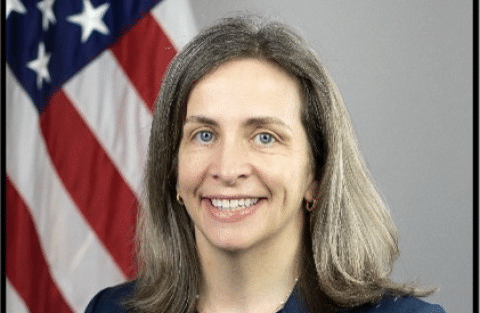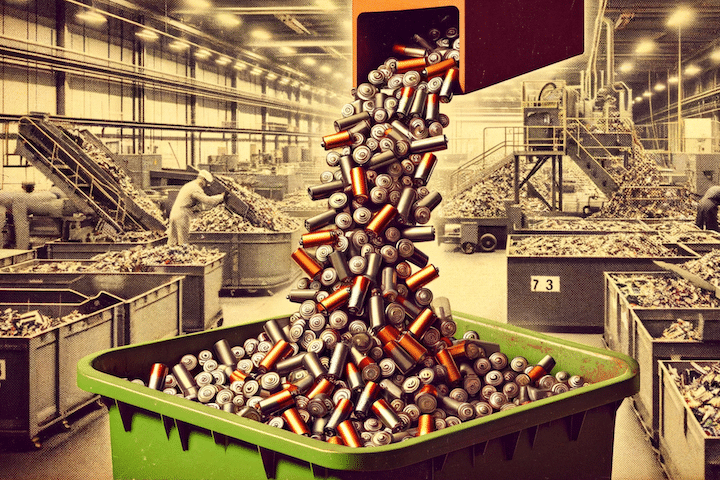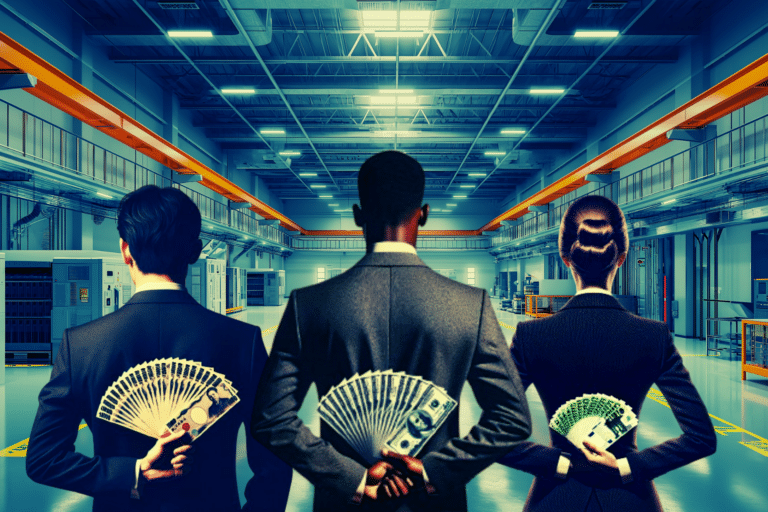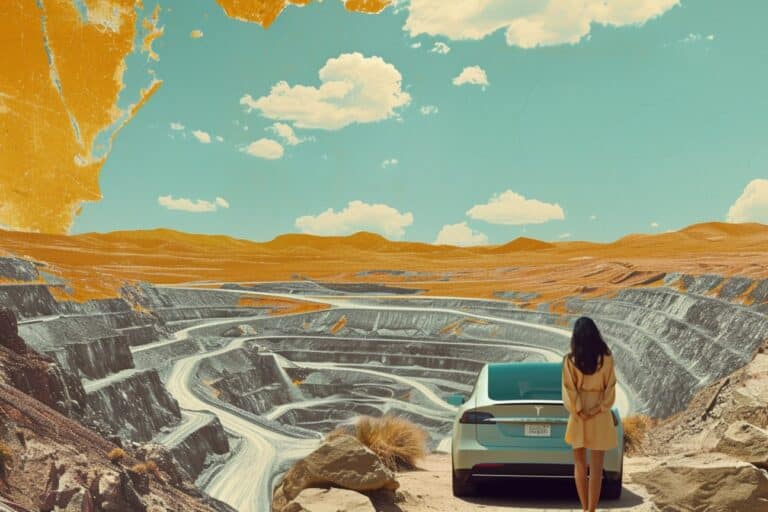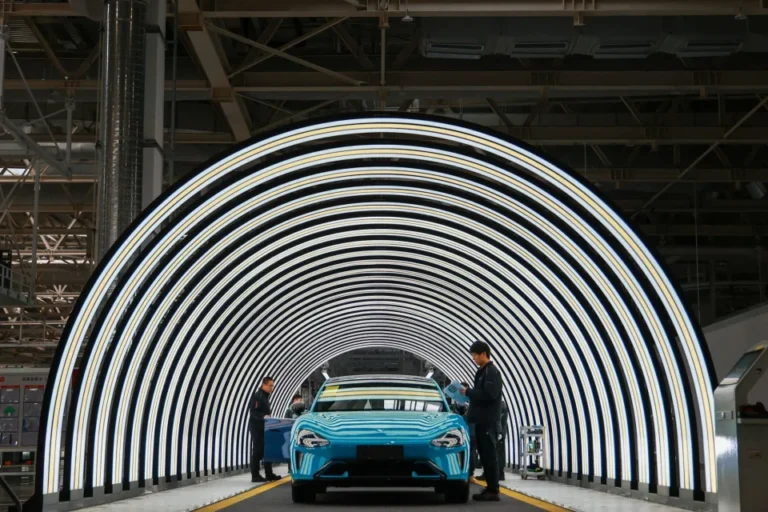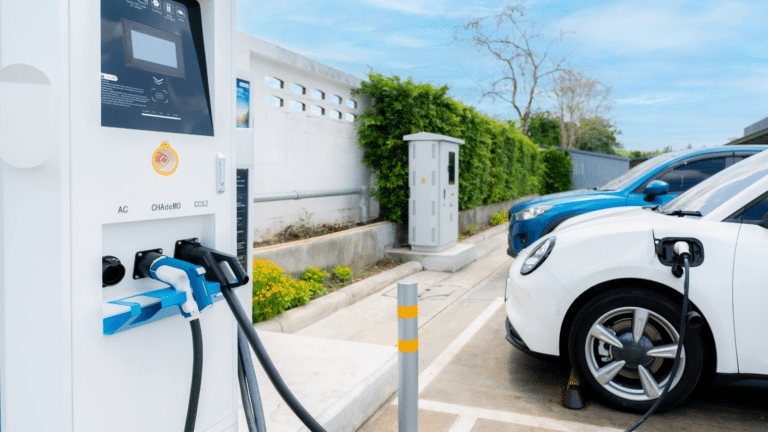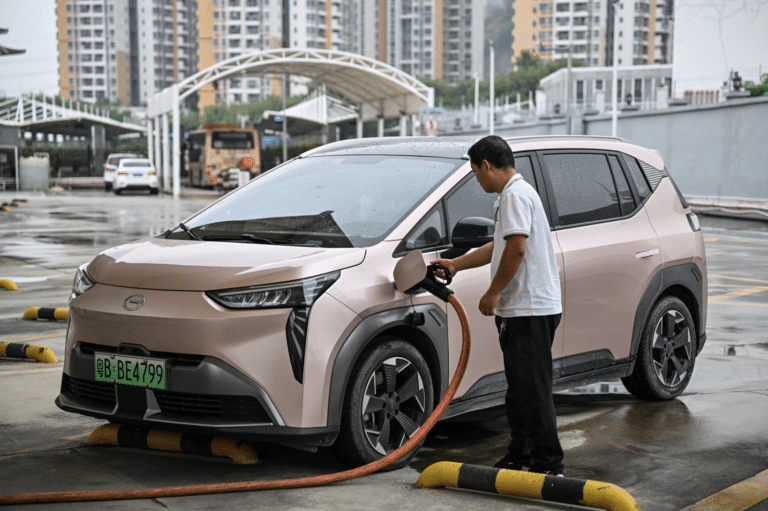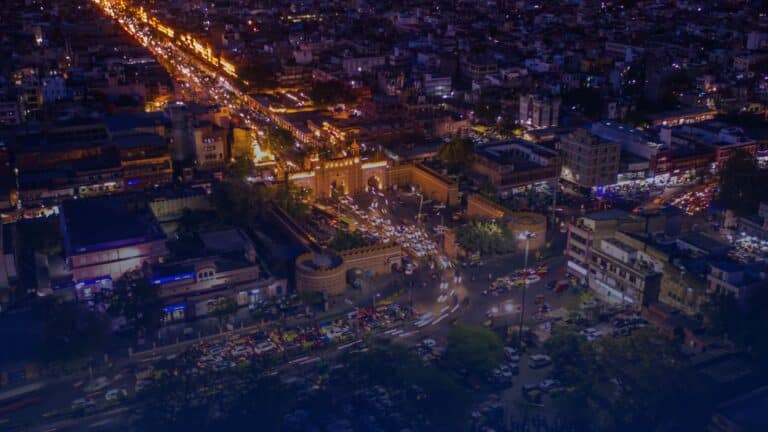Melissa Lott: [00:00:00] Picture this. Bogota, Colombia, at the heart of the city. You’ve got gleaming skyscrapers, but then the mountains and hills that surround the city, all you see are barrios popularize. In Rio de Janeiro, they’re called favelas. And these are the informal settlements for millions of people. Many have been displaced from other parts of the region, have moved, too, over the years. And if you go to one of the furthest settlements, a neighborhood called Ciudad Bolivar, you might see something kind of strange. It’s a team of researchers walking around the neighborhood with notepads and backpacks full of gear. And these packs have these little hollow tubes. Yes. Tubes sticking out of them. [00:00:35][35.1]
Dr. Olga Lucia Sarmiento: [00:00:37] I mean, it’s a normal backpack, but you will see some tubes that you usually don’t see on on backpacks. But it’s we try to be very discreet. [00:00:44][7.3]
Melissa Lott: [00:00:45] The group is a team of researchers headed by Dr. Olga Lucia Sarmiento. These researchers are recreating the routes the people of Ciudad Bolivar follow on their daily commutes. [00:00:53][8.5]
Dr. Olga Lucia Sarmiento: [00:00:54] Basically walking and recreating all the trips on the different mode of transport. [00:00:59][4.9]
Melissa Lott: [00:01:00] Dr. Sarmiento is a professor in the Department of Public Health at the University of the Andes in Bogota, where she studies the effects of the built environment on people’s health. And in this case, on the streets of Ciudad Bolivar, which are often clogged with traffic. Dr. SARMIENTO his team is studying air pollution and focusing in particular on a type of air pollution known as PM 2.5. These are tiny particles, so tiny that they can actually get deep into our lungs and even into our bloodstream, causing a lot of harm. [00:01:27][26.8]
Dr. Olga Lucia Sarmiento: [00:01:30] When you are exposed chronically to PM 2.5 mortality increases. For instance, for pregnant women, we see that babies could have a lower birth weight. We also see that individuals, for instance, with asthma could have severe pathology and they could have more symptoms. [00:01:52][21.7]
Melissa Lott: [00:01:52] With their backpacks, Dr. Saad Matos team is tracking a transformation that has begun in the area. A promising new mode of transit has come into the neighborhood and it doesn’t rely on diesel or congested roads. The researchers suspected that this new transit project wouldn’t just reduce commuters exposure to air pollution. It could also transform the economic opportunities and safety in Ciudad Bolivar. This is the Big switch, a show about how to rebuild the energy systems that are all around us. To slow climate change, we need to transform our buildings, our homes, our cars and the economy as quickly as possible. But how do we do it right? I’m Dr. Melissa Lott, and I’m the director of research at Columbia University’s Center on Global Energy Policy. And I study the technologies and systems that power our world. This is the second of our five part series on decarbonizing transportation. Today, we’re talking about public transport. Air pollution is just one big problem in a rapidly growing city like Bogota. And we’ll get back to August. Armando’s team of researchers and their air pollution sniffing backpacks later in the show. But first, another massive issue in Bogota is incredibly long commute times, especially for people in the farthest reaches of the city, like Ciudad Bolivar. [00:03:12][80.1]
Brant Marsh: [00:03:13] A big chunk of the city lives down there, but it’s also the part of the city that doesn’t really have good transit. [00:03:18][5.2]
Melissa Lott: [00:03:19] This is Brant Marsh, who lives in Bogota for several years and later returned to the city as a journalist to cover transit and see what I believe are. [00:03:26][6.9]
Brant Marsh: [00:03:26] People who live down there had to take multiple busses, wake up really early to get to work and, you know, navigate polluting busses that were not really safe. And they just spent most of the day in traffic. [00:03:42][16.0]
Melissa Lott: [00:03:43] Like Bogota, another Colombian city called Medellin, has informal settlements that face similar challenges. And Medellin tried a novel solution. Instead of paving new roads and adding busses and building metro systems or otherwise disrupting the cityscape, they built a way over the congestion with an electric cable car system. The people of Ciudad Bolivar wanted to try something similar in Bogota. [00:04:04][21.1]
Brant Marsh: [00:04:05] Community leaders in Ciudad Beauvoir said, okay, you know, we could try the same thing here. And so they they had to push for that. They had to convince other community members that this was something that could be viable. [00:04:18][13.3]
Melissa Lott: [00:04:19] And so locals teamed up with academics and political allies, and it took many years of advocacy and hard work to get the funding and then actually build the project. But ultimately, the city of Bogota constructed an electric cable car system, and the system went straight from its main rapid transit network of busses to Ciudad Bolivar and several other far flung barrios popularize. It’s called transmit Cable. Here’s Dr. Sarmiento again. [00:04:42][23.2]
Dr. Olga Lucia Sarmiento: [00:04:44] It’s a cable car. It’s a cable car that is linked to the mass transit system and provides public transportation in Bogota to the poorest population that we have up in the mountains. [00:04:59][14.6]
Melissa Lott: [00:05:00] It’s also, Brett says, a joy to ride. [00:05:02][2.1]
Brant Marsh: [00:05:03] When you’re, you know, first stepping into the system and you’re gliding above this tapestry of, you know, thousands and thousands of homes, it’s it’s a really surreal feeling. [00:05:13][10.3]
Melissa Lott: [00:05:13] Brat returned to Bogota as a journalism student at UC Berkeley to report on the new trans subway system. What he found was that the project not only offered a new transit option, but it also included government investments in public spaces around the cable car stations. [00:05:27][13.2]
Brant Marsh: [00:05:27] And then you, you know, get off at these stations and they’re surrounded by public spaces. There are social centers. There’s this whole commercial area and vibrancy around it. [00:05:38][10.2]
Melissa Lott: [00:05:38] The city built parks, painted homes, offer community programing and supported local art. [00:05:42][4.3]
Brant Marsh: [00:05:43] Local artists would paint murals. They would paint the walls of their houses along the line of sight of the trans me club to show people from outside and, you know, maybe even for their own benefit, to be like, Hey, like, we can make this place beautiful. We can paint it beautiful colors and, you know, bright, warm colors. [00:06:01][18.4]
Melissa Lott: [00:06:02] And this whole project, a new transit option in a marginalized part of the city, new public spaces, community programing and all will set off big changes that Olga Sarmiento team wanted to track. [00:06:12][10.1]
Dr. Olga Lucia Sarmiento: [00:06:13] So I always say the way you build the city, the way you implement a transport system has an important effect on your health. [00:06:22][9.4]
Melissa Lott: [00:06:22] In addition to walking around with air pollution sniffing backpacks, Olga’s team recruited what she calls citizen scientists, locals of Ciudad Bolivar, to record their experiences with the cable cars and the urban improvements. [00:06:33][10.5]
Dr. Olga Lucia Sarmiento: [00:06:34] Take pictures and record what they feel when they walk around the neighborhood. So they walk around the areas where trans Mikala was implemented with all the urban transformation. Then we analyzed with them those pictures and they all the things that they said about the pictures. And then they talk with stakeholders and policymakers to propose solutions. [00:07:00][25.8]
Melissa Lott: [00:07:01] Their research covered a lot of questions. Did the cable cars change commute times? Did it change commuters exposure to air pollution? Did the new parks, murals and community programs affect quality of life and safety? And very importantly, how did the residents feel about the changes? The information they gathered would help to explore another big question What role does this kind of innovative transit project play in decarbonizing the transportation sector more broadly? And how can we make public transportation work for people so that they don’t have to rely on cars? Bogota is actually a fantastic place to explore these kinds of questions around how we move in our cities and what parts we have to reach. Net zero. Because this isn’t the first time that Bogota has tested out innovative transit solutions to move its growing population. 20 years before transmittable, it was trying to figure out how to streamline its bus system, and it didn’t have the funds for a metro system, so it tried something else. The Trans Millennial Bus Rapid Transit System. [00:08:00][59.6]
Giovanni Circella: [00:08:01] The trans Millennium is one of the greatest example of the bus rapid transportation system. So they basically have created corridors that allow individuals to travel by bus, but on a dedicated the right of way. So we don’t really share the road with vehicles and busses that can run in a much faster way. They have dedicated stations. The access to the bus system is control, like if it was a subway system but at a cheaper cost of building this system. [00:08:32][30.6]
Melissa Lott: [00:08:33] This is Dr. Giovanni Coachella, the transportation scholar who directs the Three Revolutions Future Mobility Program at UC Davis and as a senior research engineer at Georgia Tech. [00:08:42][8.9]
Giovanni Circella: [00:08:42] Bogota has been really pioneering this system together with Christi, both in Brazil and some other places around the world, has been really among the first implementation of very, very successful BRT system, Bus Rapid Transit. I would say today the system is really showing that is not enough anymore because for the massive size of Bogota, they really need more capacity, more than what a bus rapid transit can provide. And so they’re actually experimenting new alternatives. But also they are planning to build some subway system. We don’t know yet when they will be built, but they are already implementing other solutions. And one of these is this transmitter tablet, which provides the access of four communities that were in the past underserved. [00:09:24][41.4]
Melissa Lott: [00:09:25] I spoke to him about Bogota’s transit system, which we will return to, but we also zoomed out to a larger question What is the role of public transportation in helping people get to where they want to go? In a net zero world. [00:09:36][11.5]
Giovanni Circella: [00:09:37] Today, we are making a lot of efforts with electrification of the transportation sector. But if you look at a global scale, the number of electric vehicles on the road is still very little. And at the same time, even if we trying to electrify the passenger sector, we’re still having an issue that the demand is growing and it grows with population growth. Also because individuals tend to make more trips and travel to longer distances. And this is actually a problem that we will have even more in the future as we make more efforts to bring greener technologies to the transportation sector. We also need to fight the growing demand and also promote behavioral shifts that can promote or reducing travel by car. Well, we like to say we want people to move around, but we want to have them like move around in a green way. [00:10:23][45.5]
Melissa Lott: [00:10:24] So when you think about the best and worst cases, when it comes to the future of passenger transportation, especially public and mass transportation, what’s the best outcome and what’s the worst? [00:10:33][9.5]
Giovanni Circella: [00:10:34] So the worst scenario is really that we continue on the track on which we are or even we worsen this path. If we think about the size of a country like the United States, we are roughly a 1.5 billion trips per day, according to data from the National Household Travel Survey, one of the best sources of information nationwide in the United States. And 90% of these trips, approximately are made using a personal vehicle. So this is an enormous amount of miles driven. Every day is an enormous amount of cars on our freeway system. The estimates are roughly 11 billion miles per day. That’s about 40 miles on average per American. And now let’s think about the entire world. This is only the United States, a country with live more 300, 330 million inhabitants. But let’s think when we scale this out before all the other countries, and also when we think about emerging markets like China, India, we also like to know the fleet is growing very quickly. So they have a much lower motorization rate. The United States right now, but car sales are going up and also the fleet, it’s not as efficient as sometimes in these countries as it is in Europe or United States. And so these are all things that need to be considered. And so if you think about a negative future, well, imagine this continues on this path. Not all of a lot of efforts are made to decarbonize the transportation sector and imagine also the people might drive also more in the future, because usually as the economy improves, there are more reasons to travel. And also there are new technologies coming. They could promote more travel. One of these is vehicle automation. The more vehicles become automated, the more there is more for. And it’s easier and safer and nicer to travel by car and the convenience of using a car, it becomes higher. And so this clearly translates into an increased use of cars. So if you think about this apocalyptic future, let’s imagine that vehicles don’t get electrified, at least not very quickly. We have more demand. Everybody travels by car and even like people may live actually farther away from their job because when they are traveling in an automated vehicle, they might not actually care so much that they are like, you know, making an extra five miles per day simply because the vehicle is moving by itself. And so we can get some nap in the car and relax and so on. On the other hand, we can change this feature. We can change this feature for best. So already there are a lot of efforts that are coming from countries like the European Union, but also China. Other countries are really pushing towards electrification of transportation that accounts for a big portion of reducing the carbon emissions from the transportation sector. Will it get us to be completely carbon neutral by 2050? Well, realistically, no. There is some like an eye and a limit to how much we can decarbonize the transportation sector through technology. So we need to think also at this point in the broader way, there are many other ways in which we can contain emissions and also allow more livability in cities. And this passes for behavioral changes that can take us a little bit outside of our cars. We spend way too much time today in the in our cars, and we can also use transportation infrastructure, the existing one, and also the new infrastructure that could be built in the future in a more efficient way. [00:14:03][209.6]
Melissa Lott: [00:14:04] Let’s say we do all these things right and we fast forward decades down the road. So for the next minute I’m going to be is it Marty McFly and you’re going to be Doc Brown and I want you to take me into the future. So we’ve just landed down in our flying. Is it a flying car? We’ll go with that or flying car in the future. And we’ve done these things right and we’ve gotten to a net zero future. What does my day look like if I just painted a picture? What does my day look like? What do all of our days look like? And how in what ways is it different from how my day looks like today? [00:14:37][33.4]
Giovanni Circella: [00:14:38] Let’s imagine this future, how beautiful it could be if we use the space in see these in a better way. Imagine we wake up how many years from now, 50 years from now, we will have the ability to have autonomous vehicles that will be already present at that point. So fleet of vehicles, they can move around. But also, we want to use them in a smart way. So imagine that we wake up and we don’t need to own the car. We wake up in the seat of the future where in our home we have increase our space in our home because actually we don’t need a garage anymore because we can use space more efficiently. Also, our home looks nice here because from the street, individuals don’t see anymore that ugly driveway that we’re used today where cars are parked or the big garage door. We were a beautiful window directly into our living room where we can see outside the trees and whatever is in the landscape. And we have the ability to access transportation when needed. None of us probably like to spend time for parking. None of us like to spend time driving. I mean, driving for fun for doing vacation that is actually sometimes nice, but probably is not very nice to have to drive every day in traffic or under bad weather and so on to go to work. And so imagine like, you know, we can get the possibility that a vehicle picks up directly from our home if we don’t live in a very, very close proximity from our job and will take us in a smart way in a big public transportation hub, which is also automated, where these are a feeder system of small vehicles, they go to the neighbor level, can bring everybody into a much more efficient place where we transfer the passengers in a nice way because public transportation station, unfortunately today, very often they look pretty ugly and dirty. But let’s imagine this looks much more like an airport terminal or a beautiful railway station or Europe. And we can have the ability to enter into like, you know, the city or wherever we need to go in our destination. Because if we need to go to the station, which is close by, probably our vehicle, our autonomous vehicle can directly take us there. But if we need to go to the downtown area of the city and we need to go to a theater or to a big office building is much more efficient, that we will have this big corridor, but much better public transportation system is taking us. Of course, everything is contactless. We don’t need to worry about fares automatically, like, you know, recognizing our eyes or liking or our biometrics that we have already paid our fear. They recognize our subscription model because we want to be efficient, always choose the best, best fare. So if you travel often. We are all in the bundle system in which we pay just for a monthly subscription and so we can get into the city seamless. We don’t need to wait. We don’t need to worry. We have the clearest dictation of when the vehicles are arriving and we don’t need to get stuck in traffic. Now, this could be all possible. It all seems a little bit utopia stick, but it could work very efficiently if there is the coordination between the development of the new technology like automation can be with also the public good. And I would say that there is a future potential to coordinate the private sector investments and the public agencies to try to lead towards that type of future. [00:17:58][200.0]
Melissa Lott: [00:17:59] Yes. So I think this is really fascinating because it’s a switch from thinking about transportation cars. My car gets me from here to here to actually thinking about mobility. How do I do the thing I want to do, which is to get from point A to point B and how do I do it efficiently and cleanly? And and I personally like the idea of not having to maintain my car. That’s a plus of this whole system in this future painting for us, because, you know, it’s maintained centrally, it’s maintained by someone else and they are they optimize all of that and I just get to do the thing I want to do, which is get to where I want to go with the least pain possible. And hopefully it can actually be enjoyable and fun. But, you know, maybe, maybe I’m going too far with my future. I’m not sure, but I think it could be, which sounds pretty great. And then maybe, as you said in part of that, we do still have the ability to do a fun drive on the weekend if we really wanted to be able to drive. But it’s not a requirement to do the thing we really want to or need to do. It’s optional. So we’ve got this beautiful future where, you know, we’re getting the mobility. We want more, being able to achieve the things we want to do, get to the place we want to do with the least headaches possible. And by having things be more efficient through all these different modes of transportation, that’s what you’re talking about with multimodal. So all these different modes of transportation, I’m wondering what are the key things that we do to actually achieve? If you had to pick three, what are those three key things that we can do to actually achieve this future, This feature where we get picked up by, you know, a car taken to a mass transit system, you know, whether it’s a bus or a train or something else, and get to where we want to go that way. What are those things and how can we do it and how can we do it quickly? Because, you know, the clock is ticking on all the stuff when it comes to moving to net zero. [00:19:34][95.0]
Giovanni Circella: [00:19:35] I would say we can think about different scales in which we can do things. So you suggest that I can pick three things. Well, let’s start at the local scale. Let’s think about our neighbors and they make our neighbors pleasant to walk around. Have you ever been in Vienna or Zurich or some of the beautiful places in Central Europe? It’s a great places work too. We like to walk. We can get out of our home and walk around, is very green, is very safe, is pleasant. So we really need to rethink at the local level about our streets, our public space. We need to reclaim the public space to make it feel safe, first of all, but also enjoyable because in a lot of cases, I’m the first one. I like to walk and ride a bicycle, but many places they look very scary. But even if they don’t look scary, many others, they actually look very unpleasant. And none of us like to walk just in the middle of a lot of concrete buildings with no green areas with nothing else like that. And so that is for the local scale. We really need to rethink about making the city a nice place to live and not just the environment we cross while we go from home to work or to other destination. The city is indeed our home and we need to make it livable and nice. Now, if you think about the regional level, we really need to think about giving options is too easy to say, Oh, we should reduce the use of cars. The reality is that in a lot of locations people are forced to drive a car. They live in food deserts. There is no the ability to buy anything in the close distance from their home. They are very far away from their jobs, very far away from a hospital or from stores. So for other places, and if they want to use public transportation sometimes is not available or if it is available, it might take four times the time we would take by car to get anywhere. And so we really need to think about giving options to individuals. And from this point of view, when they see options, we need to be flexible also because it is not practical to bring public transportation to everybody. But we can think about a system of flexible public transportation that can integrate new mobility services. Today we have shared bikes or e-scooters. That can be a great way to bring people closer to public transportation and make an intermodal trip Transferring to public transportation. We can have a fleet of shared vehicles Uberpool Lyft share. So the combination of different travelers that can be put in the same car to bring them to public transportation and so we can really use all these modes in combination to provide options. And a lot of these need to be done also in a way that is both convenient in terms of time and. Because we need to make it not too expensive, otherwise nobody will use it. But also need to be attractive to the end users in just one time. And then I will mention also some functions that need to be done more at the global level and national level. We need to think about really about a system of incentives to transition to cleaner technology. And when I say cleaner technology, I mean both for the private vehicles, electric vehicles, alternative fuel vehicles for private market, but also for public transportation for the rail sector, we really need to put investments in this area. But also we need to think about pricing transportation. Right. Today, traveling by car is simply too cheap. And we think that we’re giving a service. We’re giving something to people in this way. In reality, we’re not really giving a good service to society. And there is a way actually to right price transportation in the future because somehow we are called to reform our way in which we provide funding for transportation. Most of the revenues in the transportation sector today come from the gas tax. So it’s the tax that we pay on gasoline where we buy gasoline. And of course, like in the future, the more alternative fuel vehicles there will be and the more electric vehicles there will be. We need to go beyond gasoline tax. So as we rethink, as methods and approaches to tax and to price transportation properly, we can really think to do that in a smart way so we can really price of things in a way that is also pushing and creating behavioral nudges towards greener options so we can give actually lower prices if somebody is driving an electric vehicle, but also we can give higher prices and charge more if somebody is trying to drive in the timing, which is very congested or location based, if there is a good alternative to go by public transportation, why do we want to make driving in that area easy so we can think about road pricing solution and congestion pricing? This is integrated into this bigger picture about pricing of transportation, and we can do it in a very, very efficient way because in the future everything will be integrated. We have the technology, cars are connected, vehicles are connected, our smartphones are connected. So we have all the technology we need today to really do smart things about the payments associated with transportation. We just need, you know, the political will to bring this to the markets. [00:24:47][312.3]
Melissa Lott: [00:24:48] You mentioned cost a moment ago, and I wanted to get into that a little bit deeper because cost makes me think about equity. You know, I can afford to own a car. I can afford to drive that car. And that car gets me to a job that pays for my life. And maybe that job is better paying than if I couldn’t get there. So I’m thinking about this net zero transportation future. What are the worst and best cases when it comes to equity? And I’m thinking about things like access cost and also travel time. So the amount of time it takes out of our day to get to where we need to go. How do you think through those aspects of this? [00:25:19][31.3]
Giovanni Circella: [00:25:20] And this is a very, very important topic. Equity is actually now central to a lot of the work we are doing, the university community and the academic work to really study how we can try to achieve a scientific goals while at the same time improving equity aspects of transportation. Equity can actually be a very important goal that can be coordinated with environmental targets. So if we think, for example, that with technology today, we can actually try to integrate what we want to achieve for the environment with also the information we have today about who is traveling. And so we can really think about customizing that whatever plan, for example, we are talking about cost based on who is traveling. If somebody belongs to a lower income household, why should they be priced in the same way of somebody who is making $1,000,000 a year so we can really think about a more equitable way. So, for example, to reintroduce customized incentives and packages of subscription models so public transportation fares. So really the sky’s the limit about what we can think. A few minutes ago I was suggesting that pricing could be a very, very important element in the future. If you want to control in a smart way the use of private vehicles on the road network and really rebalance mode. SHIFTER So let’s think about this in the future. We don’t have any more a gas tax, so we’re going to switch towards pricing the transportation services that we access, whether it’s driving a car or taking a bus or whatever it is, based on the mode we use, the time we travel and the origin, the destination. We can make it as flexible as we want. So let’s think about this. We can actually charge fees or whatever is going to be called. It can be a VMT vehicle, miles traveled fee. It can be a fee per mile. Or a few for cheap that we do. And we can do that based on the time of the day in which we are traveling and the congestion level in the area. We can also charge it based on the type of models that we use. So if we are choosing a cleaner option, we automatically get a discount in traveling. But if we are using a more polluting vehicle we can need, we are to pay a higher price. Also, if we have alternatives, some people are forced to drive because they live in the community without an alternative. It would not be fair to charge them a lot if you want to discourage driving, but if you are driving in an area where there are very good alternatives and somebody still driving, well then they should pay a premium. I strongly believe it would be fair to charge a premium. Well, no, let’s think about it. Somebody belongs to a lower income community, sometimes actually disadvantaged communities. The data show today they need to travel actually longer distances. So actually, they could be the most affected if we start implementing systems in which we charge the use of a car by the mile they travel because some of them they cannot afford to live in San Francisco, for example, and they need to travel a very long way from their home location. Well, we can think about a dynamic system. The charges based on the household, they belong their income category with discounts of for seniors or for lower income households or for certain categories of workers, for example, they cannot travel at specific times with other options are available in might have actually the need or using a vehicle or a vehicle, for example. We can do it on the other end of the spectrum we can raise. So for, for example, improving the efficiency because we charge more when we can discourage the use of cars. This is the key rebalance pretty well. We can actually have a more equitable system of transportation and more efficient transportation system because we can actually reduce congestion and use the infrastructure in a better way. If we go back to the example of Colombia that we were discussing at the beginning of our chat today, if you think about how many individuals in a place like Bogota leave without a car because they cannot afford the car, well, there is a big equity component there. How can we provide good transportation options for all those that cannot afford buying a car today? [00:29:37][257.0]
Melissa Lott: [00:29:38] For many, many people in Bogota, buying a car is out of reach, which is why those public transportation options are essential. But many rely on the extensive but overcrowded, mostly diesel powered bus system. And for the people of Ciudad Bolivar on the outskirts of the city, commutes can last for hours. Here’s journalist Brett Marsh again. [00:29:58][19.5]
Brant Marsh: [00:29:58] Ciudad Bolivar was, you know, is in the south of the city. It’s historically been very isolated. [00:30:03][4.9]
Melissa Lott: [00:30:04] Which is why the transport system of electric cable cars, which zoomed overhead without local emissions, was so promising. Here’s Dr. Sarmiento again. [00:30:12][8.4]
Dr. Olga Lucia Sarmiento: [00:30:16] Just to give you an idea, for the farthest point in the mountain where we have one of the stations identical to the mass transit system used to take them about an hour, and now it takes them about 17 minutes. So the first thing they underscore is that they were very happy for the travel time. [00:30:36][20.3]
Melissa Lott: [00:30:36] What that means is that the people of Ciudad Bolivar can get a piece of their day back. [00:30:40][3.8]
Brant Marsh: [00:30:41] I talked to quite a few people who said that they were just really happy that this shortened commute time gave them more time with their family after work, time to have dinner, time to help their kids with their homework and just, you know, spend time with family. [00:30:54][13.6]
Melissa Lott: [00:30:55] But it wasn’t just about commute times. [00:30:56][1.5]
Dr. Olga Lucia Sarmiento: [00:30:57] Transmission is not only a transportation implementation, it’s also an urban renovation that they had because they at a renovated Parkside was an older many piece of the built environment. So the second thing that they underscore is that they were very happy and they perceive that especially the parks were renovated and they had other spaces to do physical activity and leisure activities. [00:31:24][26.7]
Brant Marsh: [00:31:25] And people are are really happy that outsiders are coming in because for the first time, I think they get a chance to help shape the narrative of this place that they’re from in a way that’s not not so much sugarcoating, you know, but saying like, okay, look, here’s this place that’s really given us a chance to show you what we are living with here. For better or for worse. [00:31:48][23.2]
Melissa Lott: [00:31:49] The exposure of commuters to air pollution also improved. [00:31:52][2.5]
Dr. Olga Lucia Sarmiento: [00:31:53] The exposure of the pollutants decrease, especially, of course, on the cable car, because it’s an electric vehicle. [00:32:01][8.1]
Melissa Lott: [00:32:01] Bogota is also addressing the urgent air pollution problem in the city by electrifying its bus fleet. It has the largest fleet of electric busses in the world outside of China, and it’s building a new metro system, which is also electric. There’s electrification. Peace is critical because it reduces harmful air pollution while also reducing. Greenhouse gas emissions in a place like Colombia. Electrification goes a long way because 73% of its electricity already comes from low carbon renewables, mostly hydroelectric power. All of these pieces are part of a larger suite of solutions that can help to decarbonize transportation. But to make public transportation successful, it has to go beyond the technologies. We have to think about the entire experience of getting people from point A to point B and the opportunities that the system creates throughout the community. [00:32:46][45.0]
Dr. Olga Lucia Sarmiento: [00:32:50] I think our recommendation based on our study is that many of this implementation of our transport systems need to go hand in hand with urban transformation and need to have also the community participation. [00:33:04][13.3]
Melissa Lott: [00:33:05] It also has to involve making the transportation experience as good as or even better than being in a car, which is important in a place that’s already dominated by cars, but also in a place like Bogota, where many people aspire to car ownership. [00:33:17][12.0]
Brant Marsh: [00:33:18] I think the big thing that, you know, even people who buy cars, their own private cars, what they appreciate is that they have a little aspect of their environment that they control. They can control what music they listen to. They can control, you know, their sense of safety to a certain extent. They can control how cool or warm they feel. When you’re in a crowded bus. You lose that agency in a lot of cases. And that’s what kind of fuels this obsession with status symbols and in a place like Bogota. [00:33:49][31.2]
Melissa Lott: [00:33:50] But for the people of Ciudad Bolivar transmittable, I showed them how public transportation could give them this more comfortable and dignified transportation experience. [00:33:57][7.0]
Brant Marsh: [00:33:58] They’re comfortable. You can get on your phone and are security cameras. And it’s just it’s really quiet as well. It’s extremely quiet. You know, there’s no there’s no diesel fuel. So you’re not coughing? I think it does. Yeah. Bring a sense of dignity to people who who take that system. At the end of the day, everybody experiences the chaos of Bogota one way or the other, and you just kind of have to at least, you know, if you if 15 minutes of your commute is as dignified, that’s that’s a start. [00:34:35][37.1]
Melissa Lott: [00:34:38] And that’s our show. Next up, big rigs, 18 wheelers, semis. We’re going to be talking about decarbonizing, heavy trucking. If you think that the show would be valuable to a colleague, a friend or in a classroom, please share it and put it on social media. Send them a link or tell him to pick up their phone right in front of you and hit subscribe. The Big Switch is produced by Columbia University’s Center on Global Energy Policy in partnership with Postscript Media. This episode was produced by Daniel Waldorf and Alexandria. Her theme music. Scoring and mixing were by Sean Marquand. A special thanks to our Columbia team Curson, Smith, Cully, Liz Smith and Natalie Volk. Our executive editor is Steven Lacy. I’m Dr. Melissa Lott, and this is the big switch. [00:34:38][0.0]
[2022.4]

